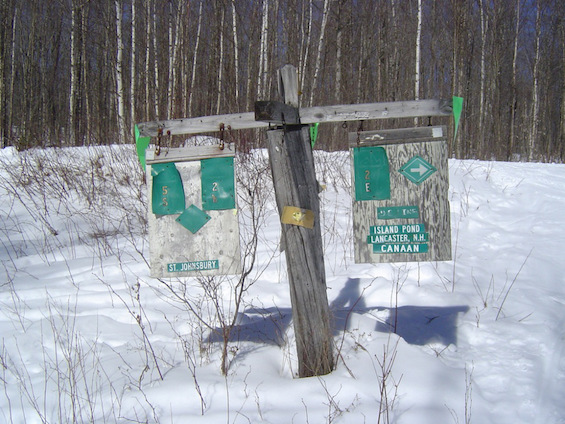
It’s no secret that fat biking has really taken off over the past couple of years, especially for riding in the winter months. Somehow, this weird little niche has become the fastest growing segment of the bicycle market. I was immediately hooked the first time I was able to borrow one and pedal around on the snow. The potential for expanding the riding season to include the long Vermont winters was an extremely enticing prospect. If you like mountain biking, it’s very difficult to understate the level of pure enjoyment these big, heavy, slow bikes bring. I now look forward to the winter biking season almost as much as I do summer.
With more people getting out on the snow, there comes the inevitable challenge of finding some trails to ride. Several groups have stepped up to the task, creating bike specific trails in the winter months – everything from organizations like Kingdom Trails and some Nordic ski centers to the odd groups of individuals that are willing to put in the sweat and effort to pack down single-tracks in the snow using snowshoes or other means. It’s a situation that has been improving every year, but the available opportunities are still found only in various pockets scattered around the state.
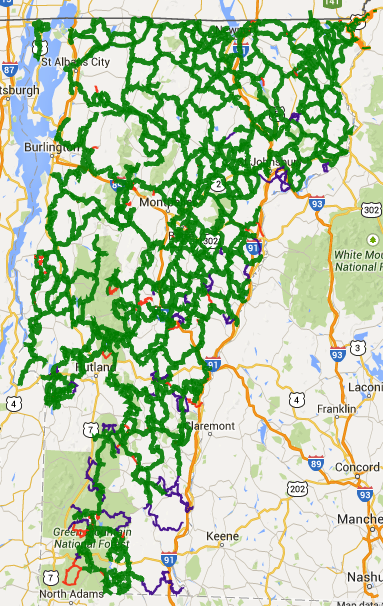
While I’d love to be able to jump into a glowing endorsement for riding on these trails, I can’t. From all technical perspectives, they more than fit the bill for great winter biking terrain. Unfortunately, the reality is that, with a very few specific exceptions, we don’t rightfully have permission to ride there. I know that it’s pretty easy to find a fellow mountain biker who has, at least occasionally, ridden on the VAST trails at one time or another, if you haven’t done so yourself. It’s one of those somewhat unspoken activities that is often viewed as a bit of a grey area. I’ve even seen articles in regional publications suggesting biking on local snowmobile trails as an option. I’m not attempting to take the moral high ground here; I’m guilty of occasionally giving in to this temptation myself.
As our numbers grow, our activities are being noticed more often by snowmobilers. Just this week I had a co-worker mention that there was some discussion about fat bikes on the trails in Vermont on one of the bigger on-line snowmobile forums. On the whole, it wasn’t really negative, but it’s an issue that will need to be addressed sooner or later by the biking community before it becomes a real problem. In some states in the mid-west, there has been quite a bit of hostility between the two user groups. Thankfully we have managed to avoid that fate, so far.
It’s important to be crystal clear about one thing before going any further with this discussion: these trails are their trail network, not ours. VAST and its members have invested a lot of time and money to get things where they are today. Many people do the hard work of clearing trails, putting up signs, creating maps and grooming these trails. Then there’s the even bigger job of working with government agencies and land owners all over the state to keep them open. This is done both as a state-wide organization and more directly by each of the individual clubs. This is much like mountain bikers have done with the various mountain bike clubs and summer trail systems around Vermont.
To put this in perspective, try to see it from their point of view. Mentally, pick your favorite mountain bike trail system. Now, how would you feel about another group vying for access to it? Maybe you helped invest in it’s development by paying membership fees, and possibly even kicked in some sweat and effort on some trail maintenance days. Would you be okay with hikers trying to get official access to use those trails? How about horses? 4-wheelers? To approach the question about whether or not we belong on these trails should be done with some humility and some expectation that we will contribute something that will benefit both groups.

Personally, I feel that fat bikes could coexist with snow machines without lessening the experience for either group. With some reasonable guidelines and education many of the potential conflicts between snowmobiles and bikes could be largely eliminated.
I think many winter bikers would gladly pay the regular fees for a VAST pass (TMA) in order to be able to use the trail system, just as we do for summer memberships. Right now, this is not an option, even for those of us who would be willing to pay our fair share. This shouldn’t be viewed as a “pay to play” option as much as it is contributing something back to help with the expenses involved in maintaining these trails. Even though our low-psi tires and low power output create almost no impact on the trails, groomers still consume a lot of fuel. Liability insurance isn’t free either. Enforcement should be handled just like it is for snowmobilers who ride without a TMA.
Some thoughts on what might constitute reasonable guidelines: Bikes should yeild to sleds; Stay to the right side of the trail; Ride single-file. There are likely others that would need to be considered. Of course, this would be the bicycle specific guidelines in addition to the code of ethics that VAST expects from its members. Most of this would be necessary to avoid injury for both the bikers and those riding a snow machine. There is a big disparity in speed that brings some obvious safety concerns. Some of the busier trails might not be appropriate for bike use and would need to be unavailable to bikes or limited to off-peak hours.
Ultimately, we are looking for many of the same things in our recreation while enjoying all that the great outdoors in Vermont has to offer. Contrary to the perception that many get from interacting with bicycles on the roads, most bicyclists have no desire to impede the enjoyment of other trail users. We’re generally a pretty laid back group and can relate to the enjoyment that other trail users get in their own way. Nobody wants to create any animosity between fat bikers and snowmobile riders.
As I mentioned earlier, winter fat biking is a rapidly growing activity and could help support the efforts of VAST and local clubs. We have had our own experiences with gaining trail access and a culture of contributing to see these interests maintained has been developed over the years. Fat biking could become another significant part of Vermont’s winter tourism opportunities. Things like organized inn to inn treks could be a real draw and a great experience even for those of us who live here throughout the year. Vermont has an opportunity to do this right with some careful thought. I’m aware than VMBA and some other mountain bike organizations have already engaged with the snowmobile groups, at least on some level. Hopefully, more discussion can occur and we can build some agreement that will avoid the contention over trail use that has become a problem elsewhere.

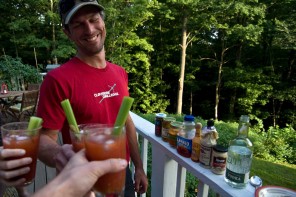
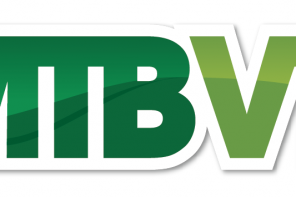
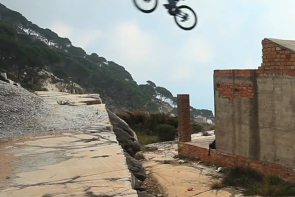
Interesting perspective. It actually goes even deeper, many State Parks are faced with the conundrum of how to integrate Fat Tire bikes into their winter trails.
I’ve had some experience with this recently, at my local State Park. We have a designated bike/walk trail (MUP) that a few of us continued to use for Fat Biking once the snow fell. It didn’t take long for the XC Skiers to complain, and Fat Bikes were quickly prohibited from the trails.
After some discussion we were able to get some of the trails reopened.
It’s important to get involved with Parks and land managers so that our needs are at least considered. It’s too easy to make a snap judgement and default to the ‘no access’ position, and that’s what some of the hierarchy will do unless the Fat Bike community steps up.
Also, I think with your suggestion of shared trails for cyclists and snowmobiles, that you have a large liability issue to consider. It won’t be long before a cyclist gets hit by an over-zealous snowmobile rider and there will be questions raised about the legitimacy of sharing trails between powered and non-powered vehicles. If the land owner becomes liable then you can understand that there will be a reluctance to compromise on the position.
There’s lots up for discussion here. The IMBA have issued a guideline on integrating fat bikes into community trails, but it’s just that – a guideline. And it’s far from comprehensive.
I wrote about my experience with the local State Park and published a blog here, for anyone that’s interested http://goo.gl/kEw0gr
It would be nice to have a place to pool all of these concerns and foster a dialogue.
CH
Personally as both a biker and a snowmobiler there is no way I see a proper collaboration. Its only a matter of time before a biker is killed. It’ll be blamed on a generally innocent rider. The last thing the trails need is a flood of bicycle traffic. A 600lb snowmobile vs a 25lb bike is a bad idea. Snowmobilers often reach speeds of over 100mph in tight wooded trails(illegal but common.) Running over a byciclest would feel like a small vibration. Only way I see this working is that a byciclest is at their own risk and have to step off the bike and off the groomed surface when a snowmobile is present. They should also carry their own liability insurance, if a bicyclest ruins my $15,000 snowmobile with no way to repay, holes would be dug in the snow. They should also have to follow the snowmobile license regulations for proper etiquette. Front and rear lighting should also be mandated even for day time use at brightness similar to a snowmobile/car headlight. I love snowmobiling and I love biking, I love drinking and I love driving, just not every combination should mix.
As a snowmobiler I can assure you that snowmobiles traveling at 100 mph almost never happens and certainly not in tight woods.
Jake, cross-country skiers and snow-shoers use the snowmobile trails here and there as well. I have yet to see any of them killed by passing snowmobiles. Why would the fat-bikes be any different?
And I do not see where a snowmobile in tight woods could ever approach the speed you suggest.
A thought to consider is what will State land use dictate with these bikes? if the State says they are able to ride there, for free, how will VAST stop them? Can they? I see a good compromise here of working together. I applaud the author.
But you do bring up some good points Jake about damage to a snowmobile when an accident was the fault of the bicyclist, as well as the suggestion of lighting. Great points to a great thought-inducing article.
VAST trails require landowner permission that is gained by the local snowmobile club…without local club and VAST membership anyone using these trails is trespassing IAW Vermont law…if others, (ie skiiers, snowshoers, walkers or bike riders) get permission from the landowner there’s no issue…joining the local snowmobile club gets you permission without asking yourself…if you ride outside your town, joining VAST gains you access (ie landowner permission) the the trails…if a landowner doesn’t want other recreational users using the snowmobile trails on their land then that wouldn’t work either…the snowmobile clubs would also be wise to mention the other uses when they annually ask for permission to continue using the trails…communication and cooperation are the best approach right from the start…
NY rider.. While many landowners whom the VAST trail system is on use them for X country skiing, (and we sledders have no issues whatsoever with our generous landowners).. the thought of hundreds of bicyclists showing up and clogging down a trail at 2-4 MPH while we are approaching at 30-50 MPH is not going to work.. its a recipe for disaster. You may as well start letting them on the interstates as the end effect will be about the same. I dont want to say they cant ride in the woods, but if the bikers want a trail system, they should organize, cough up a ton of money as we already have done, and build a system that is for them and them alone. As I type, an ugly incident has just occured in the Burke area on 4- 11 and its riled up the snowmobilers pretty good, and for good reason. Sometimes,.. you just have to realize that oil and water dont mix.
Well said. I agree that common sense and mutual respect would go a long way towards heading off conflicts with snowmobilers and any other trail user group. Recently I read an article in Vermont Life magazine (http://vermontlife.com/engine-light-flashing-changing-times-hit-snowmobiling/) which said “…over little more than a decade, the number of participants has shown a steep decline. In the winter of 2002–2003, membership in the Vermont Association of Snow Travelers stood at about 45,000. By last year, the number had dropped to about 23,000, a plunge of almost 50 percent.” Perhaps forging a partnership with MTBVT would boost both VAST and VT tourism and be a win-win.
Good article, however, each club has gotten landowner permission to ride on the trails that cross landowner property. I recommend approaching and joining your local snowmobile club and VAST if you want legal access to the snowmobile trails. Snowmobilers must belong to their local club AND VAST to ride the trails to avoid trespassing. In the early years of snowmobiling there was a similar issue with cross country skiiers and shoeshoers using the trails without joining their local snowmobile club. Eventually many did join (which gave them the legal right to use the trails) and worked together for trail improvement and mutual understanding (usually neighbors or fellow townspeople with different recreational pursuits) to the benefit of all. Safety is always a concern having skiiers or bikes or snowshoers on snowmobile trails. Snowmobile riders must keep an eye out for wildlife, XC skiiers, and now possibly bike riders. Seek to understand, be respectful and enjoy Vermont!
Our local club, the Mad River Ridge Runners, has a non-motorized trail user pass for $15.00. A bunch of us have paid in and are enjoying the VAST network here in the Mad River Valley. It is certainly not ideal as it is not “single track”, the big climbs are laid out for a throttle and the flats can feel like road biking but when you have no other access or it’s so cold that the snow on the mtb trails will not compact, it’s the best alternative.
Fat Bikes are and will be a recognized user on the new Lamoille Valley Rail Trail which once completed will offer around 98 miles of groomed trail across the state. There are sections groomed and rideable this year. Fat bikes are listed as one of the user groups in the trail’s management plan. More info. and a pdf. of the management plan at: http://lvrt.org/
I ride a section of this trail regularly and have been passed by countless snowmobilers. The only interactions I’ve had have been very positive and many have stopped to investigate and inquire about my fatbike. All have been impressed and all have been hospitable.
It doesn’t seem right that VAST has borne the entire financial and physical fight to start, design, repair, permit, and continue the LVRT. The State of Vermont forced the Act 250 permit on them almost as a punishment yet this trail will be open to an ever widening group of users? Doesn’t seem right –
I live in Mass a couple of miles from Vermont. I have been riding on snowmobile trails for 25 years (on studded tires) in Mass, Vermont, and New Hampshire. You can hear snowmobiles coming (although they are MUCH quieter than they used to be). I always get off, pull to the edge or off the trail and wave as they go by. People are always friendly. I’ve never had a problem. I was out yesterday; the only other person I saw was on a fat bike. I wouldn’t ride at night without a VERY bright light.
A big high five to addressing this topic. Over the past 30+ years I have been guilty of spending 90% of my annual ATB hours on the VAST snowpack we are blessed with. While riding those packed pleasures I have viewed myself as a remora fish – commensalism at its evolutionary peak. Join VAST. Wave with a fist – all 5 fingers out mean 5 behind you. Help with trail work. Do a stint in the local cook shack. Enjoy the firmest trails EARLY & strive to not be seen.
Suck it in quietly.
State and Federal Partners Collaborate to Expand Fat Bike Access in Vermont
Montpelier, VT March 23, 2015
The Vermont Mountain Bike Association (VMBA) recently met with the Vermont Dept. of Forests Parks and Recreation (FPR), the US Forest Service and, the Vermont Association of Snow Travelers (VAST) to address the management of fat biking throughout Vermont.
As fat bikes are gaining in popularity, riders have been seeking places to enjoy the Vermont winter. This has led them to the groomed trails of the VAST network. 85% of the VAST trail network is located on private lands, with permission granted exclusively for snowmobiles. Fat bikes are not allowed on these trails and there have already been some reports of user conflict.
In the effort to promote the safety of all winter recreationists, VMBA has teamed up with VAST, FPR, and the Forest Service to identify appropriate locations on public lands where fat bikers and snowmobilers could enjoy shared use.
A statewide assessment has been initiated that will identify opportunities where fat bikers can further enjoy their state and federal lands. With established parking lots, public access, and a 35 mph speed limit for snowmobiles, public lands provide an ideal location for shared use trails. The goal is to have these areas identified, marked, and a trail ethic developed for the ’15/’16 winter season.
VMBA is excited to explore fat biking opportunities in Vermont with VAST, FPR, and Forest Service for the ‘15/’16 riding season. Over the next few months, all stakeholders will be sharing information, identifying appropriate trails, and developing strategies for maintenance and grooming.
For the remainder of this winter, FPR has provided opportunities for fat biking on campground roads in Allis, Fort Dummer, Gifford Woods, Molly Stark, Discovery and Quechee State Parks.
Looks like a LOT of walking and taking up the WHOLE trail…if this example is representative of Fat Bikes coexisting with snowmobiles this is NOT a good match…also, if any one of these bikers are not a VAST member they were trespassing…it’s disrespectful of the landowners and the snowmobile clubs that have taken the time to get permission and maintain these trails…
https://www.youtube.com/watch?v=YQOTW2cdzPg&feature=youtu.be&hc_location=ufi
Chez nous c’est Ski-Doo ! Not sure that I would like to share the snowmobile trail here in Qc .On the road Qc drivers are not the best in north america , so in the trail it’s just gonna be worst .